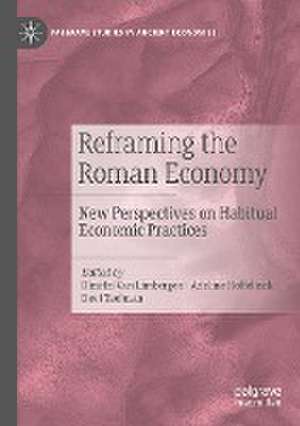Reframing the Roman Economy: New Perspectives on Habitual Economic Practices: Palgrave Studies in Ancient Economies
Editat de Dimitri Van Limbergen, Adeline Hoffelinck, Devi Taelmanen Limba Engleză Paperback – 19 noi 2023
| Toate formatele și edițiile | Preț | Express |
|---|---|---|
| Paperback (1) | 1002.31 lei 6-8 săpt. | |
| Springer International Publishing – 19 noi 2023 | 1002.31 lei 6-8 săpt. | |
| Hardback (1) | 1007.65 lei 6-8 săpt. | |
| Springer International Publishing – 19 noi 2022 | 1007.65 lei 6-8 săpt. |
Preț: 1002.31 lei
Preț vechi: 1222.33 lei
-18% Nou
Puncte Express: 1503
Preț estimativ în valută:
191.79€ • 208.99$ • 161.61£
191.79€ • 208.99$ • 161.61£
Carte tipărită la comandă
Livrare economică 23 aprilie-07 mai
Preluare comenzi: 021 569.72.76
Specificații
ISBN-13: 9783031062834
ISBN-10: 3031062833
Pagini: 406
Ilustrații: XXV, 406 p. 63 illus., 40 illus. in color.
Dimensiuni: 148 x 210 mm
Greutate: 0.51 kg
Ediția:1st ed. 2022
Editura: Springer International Publishing
Colecția Palgrave Macmillan
Seria Palgrave Studies in Ancient Economies
Locul publicării:Cham, Switzerland
ISBN-10: 3031062833
Pagini: 406
Ilustrații: XXV, 406 p. 63 illus., 40 illus. in color.
Dimensiuni: 148 x 210 mm
Greutate: 0.51 kg
Ediția:1st ed. 2022
Editura: Springer International Publishing
Colecția Palgrave Macmillan
Seria Palgrave Studies in Ancient Economies
Locul publicării:Cham, Switzerland
Cuprins
Chapter 1: Pathways to reframing the Roman economy: from uniformity to diversity?.- Part I Unusual actors, attitudes and perspectives.- Chapter 2: Textile economy in the Veneto Region (North-Eastern Italy): a textile tools oriented spatial approach.- Chapter 3: Craftsmen and shopkeepers serving the army: the example of the colony of Lugdunum (1st century AD).- Part II Unconventional loci of production.- Chapter 5: Roman metallurgic production in the Veneto region between urban and rural contexts.- Chapter 6: Pigs in the city, bees on the roof: intra-urban animal husbandry and butchery in Roman Spain.- Chapter 7: Olive Oil Production and Economic Growth in the Roman Provinces: the Peculiar Case of Volubilis in Mauretania Tingitana.- Chapter 8: Roman road stations in Gallia Cisalpina: an archaeological approach to elusive central places.- Chapter 9: Ephemeral Economies? Investigating Roman wetland exploitation in the Pontine marshes (Lazio, Central Italy).- Chapter 10: Settling the Salinaria? Evaluating site location patterns of Iron Age and Roman salt production in northern Gaul.- Chapter 11: Ollae, cistulae, cadi, utres, cupae and other intangible vessels in the Roman economy. Some case studies.- Part V Revising traditional narratives.- Chapter 12: Reconstructing economic rural landscapes. The case of southern Etruria.- Chapter 13: Ancient Indian Ocean Trade and the Roman Economy.
Notă biografică
Dimitri Van Limbergen is a researcher at Ghent University, Belgium. His main areas of study are Roman archaeology and economic history.
Adeline Hoffelinck is a researcher at Ghent University, Belgium. She researches the transformation of commercial infrastructure in Roman cities during their urbanization.
Devi Taelman is a researcher at the Vrije Universiteit Brussel, Belgium. He is interested in the study of the economy of ornamental stones used in antiquity, and in human-environment interactions in Roman Antiquity.
Adeline Hoffelinck is a researcher at Ghent University, Belgium. She researches the transformation of commercial infrastructure in Roman cities during their urbanization.
Devi Taelman is a researcher at the Vrije Universiteit Brussel, Belgium. He is interested in the study of the economy of ornamental stones used in antiquity, and in human-environment interactions in Roman Antiquity.
Textul de pe ultima copertă
This book focuses on those features of the Roman economy that are less traceable in text and archaeology, and as a consequence remain largely underexplored in contemporary scholarship. By reincorporating, for the first time, these long-obscured practices in mainstream scholarly discourses, this book offers a more complete and balanced view of an economic system that for too long has mostly been studied through its macro-economic and large-scale – and thus archaeologically and textually omnipresent – aspects. The topic is approached in five thematic sections, covering unusual actors and perspectives, unusual places of production, exigent landscapes of exploitation, less-visible products and artefacts, and divergent views on emblematic economic spheres. To this purpose, the book brings together a select group of leading scholars and promising early career researchers in archaeology and ancient economic history, well positioned to steer this ill-developed but fundamental field of theRoman economy in promising new directions.
Dimitri Van Limbergen is a researcher at Ghent University, Belgium. His main areas of study are Roman archaeology and economic history.
Adeline Hoffelinck is a researcher at Ghent University, Belgium. She researches the transformation of commercial infrastructure in Roman cities during their urbanization.
Devi Taelman is a researcher at the Vrije Universiteit Brussel, Belgium. He is interested in the study of the economy of ornamental stones used in antiquity, and in human-environment interactions in Roman Antiquity.
Adeline Hoffelinck is a researcher at Ghent University, Belgium. She researches the transformation of commercial infrastructure in Roman cities during their urbanization.
Devi Taelman is a researcher at the Vrije Universiteit Brussel, Belgium. He is interested in the study of the economy of ornamental stones used in antiquity, and in human-environment interactions in Roman Antiquity.
Caracteristici
Focuses on those features of the Roman economy that have remained largely underexplored in contemporary scholarship Offers a more complete and balanced view of the Roman economic system Analyses divergent views on emblematic economic spheres in the Roman economy






